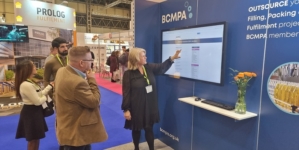-
ROSSLARE EUROPORT TARGETS HEALTH & SAFETY WITH CAMERA TELEMATICS PARTNERSHIP - 2 days ago
-
Landmark Study Reveals Wearable Robotics Significantly Boost Safety and Efficiency in Industrial Environments - July 24, 2024
-
Visku Tackle The Retail Seasonality Challenge One Pallet At A Time - July 22, 2024
-
KAMMAC AND BERGEN LOGISTICS STRENGTHEN FASHION & LIFESTYLE SERVICES IN THE UK - July 19, 2024
-
TENTBOX EXTENDS PARTNERSHIP WITH ARROWXL TO SUPPORT INCREASING DEMAND - July 17, 2024
-
The Perfume Shop improves customer journeys while driving profitability in partnership with Scurri - July 17, 2024
-
ZEROMISSION SECURES £2.3M ($3M) INVESTMENT TO ACCELERATE ELECTRIC FLEETS - July 16, 2024
-
BCMPA CELEBRATES SUCCESS OF 2024 CONFERENCE - July 15, 2024
-
Best of the Best: Jungheinrich Celebrates Triple International Award Win - July 12, 2024
-
GOPLASTICPALLETS.COM CALLS ON NEW CHANCELLOR RACHEL REEVES TO CONSIDER PLASTIC PACKAGING TAX REFORM - July 10, 2024
Top 10 retail trends for 2017 and beyond.
By Jerry Koch
I recently presented an On The Move webinar where I discussed the retail trends for 2017 and beyond. After compiling the data from various industry sources, what struck me was how much these trends have evolved in a relatively short period of time. In the last 10 years, traditional retailers and e-tailers alike have lived through a dynamic transition in the marketplace. As consumer expectations, demographic changes and the growth of e-commerce drive distribution and fulfillment strategies, our industry will need to continue to adapt.
What follows are the top 10 retail trends for 2017 that are impacting retailers now – and which most likely will affect their operations well into the future.
1. Population densities concentrated in major cities. With 82 percent of the U.S. population living in and around major cities, retailers must adapt to consumer behaviors by offering urban store formats and updating distribution and fulfillment strategies that enable direct-to-consumer deliveries.
2. Continued e-commerce growth. E-commerce is here to stay. Over the last decade, the calculated annual growth rate of e-commerce vs. total retail sales is 14.5 percent. Year over year, e-commerce sales continue to outpace traditional retail sales by significant margins.
3. Brick-and-mortar retailers struggle online. Traditional retailers aren’t necessarily capitalizing on e-commerce opportunities. Although retail sectors are impacted differently, overall e-commerce growth for these retailers is on the decline.
4. Amazon continues to dominate e-commerce. In 2016, 4 out of every 10 U.S. dollars spent online were with Amazon. The rest of the top internet retailers are growing at a lesser rate than Amazon, with each segment requiring specific fulfillment strategies to accommodate their product profiles and customer service level agreements.
5. E-commerce SKU proliferation. For typical retailers, the number of products available online greatly outnumber those stocked in their outlets. This reality creates complexities in the distribution and fulfillment process: as more individual items are ordered, picking requirements increase in the warehouse.
6. Cross-channel shopping is the new norm. 38 percent of shoppers utilize multiple channels (omnichannel) in their shopping process. Of those who use a single channel, 42 percent search and buy online, while 20 percent search and buy in stores.
7. Generation Z is going back to stores. 98 percent of Gen Z (younger than 18 years of age) prefer to shop in stores. Product quality is most important to them, so the opportunity to inspect these products first-hand is imperative. Retailers will have to closely monitor their buying preferences as they mature.
8. More consumers buy online and pick up in stores (BOPIS). To offset shipping costs and add convenience to the buying process, consumers are increasingly utilizing stores to pick up online orders. Of the 50 percent who have done this, 46 percent make additional purchases at the store.
9. Dimensional weight (DIM) pricing changes packaging profiles. To increase the density of parcel carrier trucks and improve last-mile shipping efficiencies, DIM pricing continues to drive the packaging profiles away from traditional cartons to polybags.
10. Labor challenges persist. With the retail industry labor market at nearly full employment in 2016, warehouse operations are challenged with recruiting, training and retaining talented employees.
It’s clear that everyone must have an e-presence to drive and achieve their sales targets moving forward. To do so, retailers will need to develop omnichannel distribution and fulfillment strategies to delight customers and meet challenging service level agreements.
To learn more about trends in the retail space, please view this webinar in its entirety.

































